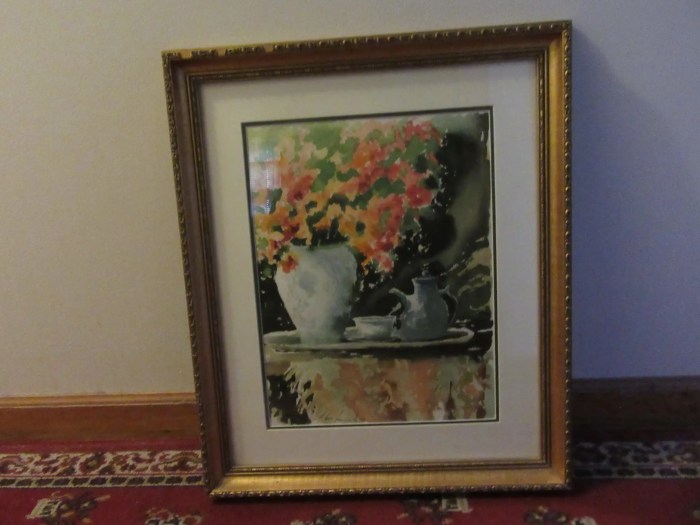Vintage Wall Art A Collectors Guide
Vintage wall art transcends mere decoration; it’s a portal to bygone eras, whispering tales of artistic movements and cultural shifts. From the bold geometry of Art Deco to the organic curves of Mid-Century Modern, each piece carries a unique history, reflecting the social and aesthetic sensibilities of its time. This exploration delves into the diverse world of vintage wall art, examining its defining characteristics, popular styles, and the crucial aspects of sourcing, displaying, and preserving these captivating artifacts.
We will navigate the fascinating landscape of materials and techniques, from the rich hues of oil paints to the delicate artistry of watercolors, and explore how these choices contribute to the overall aesthetic appeal. Furthermore, we’ll discuss the cultural significance of vintage wall art, its presence in popular media, and the ways in which contemporary artists continue to draw inspiration from these timeless designs.
Ultimately, this guide aims to equip enthusiasts with the knowledge and confidence to appreciate, acquire, and cherish these remarkable pieces of art.
Defining “Vintage Wall Art”
Vintage wall art encompasses a broad range of decorative pieces that evoke a sense of nostalgia and history. It transcends mere decoration, offering a window into past aesthetics and artistic trends. The definition encompasses a variety of styles, materials, and eras, all united by their age and the inherent charm associated with their history.The characteristics distinguishing vintage wall art from other forms of wall décor primarily revolve around age and aesthetic.
Unlike contemporary art prints or mass-produced posters, vintage wall art possesses a unique patina, often showing signs of wear and tear that add to its character. This could include faded colors, minor imperfections, or even subtle damage that tells a story of its past. Furthermore, the materials used are often distinct, featuring techniques and craftsmanship not commonly found in modern productions.
The inherent rarity of many vintage pieces further contributes to their value and appeal.
Styles and Eras of Vintage Wall Art
Vintage wall art spans numerous styles, reflecting the evolving tastes and artistic movements of different eras. For instance, Art Deco pieces from the 1920s and 30s are characterized by geometric patterns, bold colors, and streamlined designs. Mid-century modern artwork, prevalent from the 1940s to the 1960s, often features organic forms, muted palettes, and a focus on functionality. Examples include posters advertising iconic films or travel destinations from those decades.
Later periods, such as the 1970s, saw the rise of psychedelic art with vibrant colors and swirling patterns, often printed on fabrics like velvet or heavy cotton. The distinct styles of each era contribute to the unique identity and appeal of vintage wall art. A piece might depict a 1950s pin-up girl in a classic style, or a 1920s flapper in an Art Deco illustration.
The subject matter itself often reflects the cultural and social contexts of its time.
Materials and Techniques in Vintage Wall Art
The materials used in vintage wall art contribute significantly to its character and value. Oil paintings on canvas, watercolors on paper, and lithographic prints are common examples. The techniques employed, such as hand-stenciling, woodblock printing, or hand-painting, often reveal a level of craftsmanship not found in mass-produced items. The use of specific materials like aged wood frames, textured papers, or particular types of inks further adds to the overall aesthetic and historical context.
For example, the use of specific pigments in oil paints can indicate the piece’s age and origin, while the type of paper used in a watercolor painting can provide clues about its historical period. These details contribute to the authentication and appreciation of vintage wall art.
Historical Context and Evolution
The historical context significantly influences the style and meaning of vintage wall art. Early examples often reflect prevailing artistic movements and social trends. For example, propaganda posters from wartime periods convey the political climate and social messages of their time. The evolution of printing techniques also impacted the availability and styles of vintage wall art. The advent of lithography in the 19th century allowed for mass production of prints, making art more accessible to a wider audience.
The subsequent development of screen printing in the 20th century further expanded the possibilities for artistic expression and the creation of unique and collectible pieces. The evolution of materials and techniques has therefore shaped the diverse landscape of vintage wall art, making each piece a unique artifact reflecting its historical moment.
Popular Vintage Wall Art Styles
The allure of vintage wall art lies in its ability to transport us to bygone eras, each style reflecting the unique aesthetic sensibilities of its time. Understanding these distinct styles allows for a more informed appreciation and selection of pieces that resonate with personal taste and home décor. This section will explore some of the most prevalent vintage wall art styles, examining their defining characteristics and offering a comparative overview.
Art Deco
Art Deco, flourishing in the 1920s and 30s, is characterized by its geometric shapes, streamlined forms, and luxurious materials. Think bold zigzags, sunbursts, stylized flora and fauna, and a strong emphasis on symmetry. Color palettes often feature rich jewel tones, metallic accents, and contrasting black and white. Art Deco pieces frequently incorporate inlaid materials like mother-of-pearl or ebony, adding to their opulent feel.
A common example would be a poster depicting a stylized cityscape with geometric buildings and vibrant colors.
Mid-Century Modern
Mid-Century Modern, spanning roughly from the 1930s to the 1960s, presents a stark contrast to Art Deco’s opulence. This style prioritizes clean lines, organic forms, and functionality. Natural materials like wood and rattan are frequently used, alongside bold, graphic patterns and a muted color palette often including shades of brown, beige, and teal. Think of a lithograph featuring abstract shapes and muted tones, or a wood-framed print showcasing a stylized landscape.
The focus is on simplicity and elegance, reflecting a post-war optimism and a move towards functionality.
Victorian
Victorian-era art, spanning the reign of Queen Victoria (1837-1901), is characterized by its ornate details, rich colors, and romantic themes. Think intricate floral patterns, detailed botanical illustrations, and scenes depicting idyllic landscapes or historical events. Darker, richer colors like deep reds, greens, and golds are prevalent. The style often incorporates heavy framing and embellishments, reflecting the era’s penchant for lavishness and craftsmanship.
A typical example might be an oil painting of a romantic landscape with meticulously rendered details or a framed botanical print showcasing exquisite floral arrangements.
Comparison of Styles
While all three styles represent distinct eras, they offer a fascinating study in contrasts. Art Deco’s geometric precision stands in opposition to the organic forms of Mid-Century Modern, and both differ greatly from the ornate detail and romantic themes of Victorian art. Art Deco’s luxurious materials and rich colors contrast sharply with Mid-Century Modern’s emphasis on natural materials and muted tones.
Victorian art, with its intricate details and heavy framing, embodies a sense of grandeur absent in the cleaner lines of the other two styles. Each style reflects the social, economic, and artistic climate of its time, providing a unique window into the past.
Materials and Techniques Used in Vintage Wall Art
The materials and techniques employed in creating vintage wall art are as diverse as the artistic movements themselves, reflecting the available resources and evolving artistic sensibilities of each era. The choice of materials significantly impacted not only the visual aesthetic but also the longevity and overall feel of the finished piece. Understanding these choices offers valuable insight into the artistic intentions and the socio-cultural context of the artwork.The selection of materials and techniques was often dictated by both practical considerations and artistic expression.
Accessibility, cost, and the desired effect all played a role in shaping the final product. For instance, the widespread availability of oil paints in the 18th and 19th centuries led to their prominent use in many portrait and landscape paintings, while the relative scarcity of certain pigments influenced color palettes and artistic styles.
Common Materials in Vintage Wall Art
A wide array of materials contributed to the creation of vintage wall art, each lending unique properties to the finished piece. Oil paints, known for their rich colors and luminosity, were favored for their ability to create depth and texture. Watercolors, with their delicate transparency, offered a contrasting approach, often employed for landscapes and botanical illustrations. Wood panels served as durable supports, particularly for oil paintings, while canvas offered a more flexible alternative.
Metal, often in the form of sheets or sculptures, provided a unique surface for various artistic treatments, from enameling to engraving. Paper, in various weights and textures, served as a substrate for prints and drawings. Finally, the use of plaster and other mixed media expanded the possibilities even further, adding dimension and texture.
Artistic Techniques Across Eras, Vintage wall art
Various artistic techniques were employed throughout different historical periods, each reflecting the technological advancements and stylistic preferences of the time. Etching, a printmaking technique involving the use of acid to create lines on a metal plate, allowed for intricate detail and precise lines, frequently seen in 17th and 18th-century prints. Lithography, a process using a stone or metal plate to create prints, offered a broader range of tonal variations and was popular in the 19th and early 20th centuries, notably used in posters and illustrations.
Screen printing, a more modern technique, enabled the mass production of prints with vibrant colors, becoming prominent in the mid-20th century, often associated with Pop Art and other movements. Other techniques such as woodblock printing, particularly prominent in East Asian art, involved carving designs into wood blocks and applying ink to create prints.
Impact of Material Choices and Techniques on Aesthetics
The interplay between materials and techniques profoundly shaped the aesthetic qualities of vintage wall art. The smooth surface of a metal etching contrasted sharply with the textured surface of an oil painting on canvas. The delicate washes of watercolor created a different visual impact than the bold strokes of oil paint. The choice of paper – its weight, texture, and color – could dramatically affect the overall appearance of a print or drawing.
For example, the matte surface of a heavy watercolor paper contrasted with the smoother surface of a lithograph printed on fine paper. The use of specific pigments, the type of wood used for a panel, or the choice of metal for an etching all contributed to the unique aesthetic of the finished artwork, adding layers of meaning and visual interest.
Sourcing and Authenticity of Vintage Wall Art

Source: patch.com
Acquiring authentic vintage wall art requires diligence and a keen eye. The thrill of the hunt, however, is often rewarded with unique pieces that add character and history to any space. Understanding where to look and how to identify genuine articles is crucial for successful sourcing.Locating vintage wall art involves exploring diverse avenues, each offering a unique selection and level of expertise.
The process of authentication necessitates a combination of visual inspection, research, and sometimes, professional appraisal. Finally, several factors contribute to the overall value and desirability of these pieces, impacting their price and collectability.
Places to Find Vintage Wall Art
Finding vintage wall art can be an exciting adventure. Antique shops, often family-run businesses with decades of experience, frequently house curated collections of vintage and antique artwork. These shops often specialize in specific periods or styles, providing a focused selection. Flea markets and antique shows present a more chaotic, yet potentially rewarding, environment. You’ll find a vast array of items, often at lower prices, requiring more time and patience to uncover hidden gems.
Online marketplaces, such as eBay and Etsy, offer global reach, exposing you to a wider variety of sellers and pieces. However, online purchases require extra caution to avoid reproductions or scams. Estate sales and auctions are also excellent resources, particularly for larger or more valuable pieces. Often, these offer unique opportunities to acquire items with proven provenance.
Identifying Authentic Vintage Wall Art
Several key factors contribute to authenticating vintage wall art. A thorough visual inspection is paramount. Look for signs of age, such as wear and tear consistent with the claimed age of the piece. Craquelure (fine cracks in the paint or varnish) is a common sign of age, but can also be artificially created. Examine the materials used; genuine vintage pieces often employ materials and techniques no longer in common use.
Research the artist or style; cross-referencing with reputable art databases and books can help verify authenticity. Compare the piece to known examples of similar works. If possible, seek expert opinions from appraisers or art conservators, especially for valuable pieces. Be wary of overly perfect condition; truly vintage pieces usually show some signs of age. Pay close attention to the signature (if present) and examine its style and consistency with the artist’s known signatures.
Finally, scrutinize the provenance; a documented history tracing the piece’s ownership can greatly enhance authenticity.
Factors Influencing Value and Desirability
The value and desirability of vintage wall art are influenced by a confluence of factors. The artist’s reputation is a primary driver; renowned artists naturally command higher prices. Rarity plays a significant role; limited edition prints or unique pieces are more valuable than mass-produced items. The condition of the artwork is crucial; well-preserved pieces in excellent condition fetch higher prices than damaged ones.
The style and period of the artwork also influence its value; certain styles and periods are more popular and sought-after than others. The materials used contribute to the value; pieces crafted from high-quality materials are typically more valuable. Finally, provenance, or documented ownership history, adds significantly to the value and desirability of a piece, providing verifiable authenticity and potentially a compelling narrative.
For example, a painting with a documented history of ownership through a notable collector will command a higher price than an identical painting with an unknown history.
Displaying and Integrating Vintage Wall Art into Interior Design

Source: walmartimages.com
Integrating vintage wall art effectively transforms a space, adding character and history. The key is to understand the piece’s style and how it interacts with the existing décor, creating a cohesive and visually appealing environment. Careful consideration of placement, framing, and the overall aesthetic will ensure your vintage art becomes a focal point, rather than a clashing element.
Successful integration hinges on understanding your existing interior design style and selecting vintage art that complements it. A rustic farmhouse style might benefit from a collection of botanical prints in simple, wooden frames, while a mid-century modern space could showcase bold geometric designs in sleek, metallic frames. Consider the color palette, textures, and overall mood of the room to ensure a harmonious blend.
Placement and Arrangement of Vintage Wall Art
Strategic placement maximizes the impact of your vintage wall art. Consider the size and scale of the artwork relative to the surrounding furniture and architectural features. A large, statement piece might anchor a seating area, while smaller prints can be grouped together to create a gallery wall. Avoid overcrowding, allowing each piece to breathe and be appreciated individually.
|
Option 1: Single Statement Piece |
Option 2: Gallery Wall |
Option 3: Themed Grouping |
Option 4: Leaning Against a Wall |
Choosing the Right Frames and Mounting Options
The frame is as important as the artwork itself. It should complement the style of the art and the overall aesthetic of the room. For delicate vintage prints, consider using archival-quality mats and frames to protect the artwork and prevent damage. Different mounting options cater to various needs.
For instance, a delicate watercolor painting might require a shadow box frame to protect it from dust and light, while a sturdier print might look stunning in a simple, elegant frame. The frame material – wood, metal, or even repurposed materials – should complement the art and room’s style. Ensure the mounting method is appropriate for the artwork’s weight and fragility, and always prioritize proper conservation techniques to protect your investment.
The Cultural Significance of Vintage Wall Art
Vintage wall art serves as a powerful lens through which we can examine past cultural trends, artistic movements, and societal values. Its enduring appeal lies not only in its aesthetic qualities but also in its ability to evoke a sense of nostalgia and connect us to bygone eras. The styles, materials, and subjects depicted often reflect the dominant social, political, and economic climates of their time, offering valuable insights into the past.Vintage wall art reflects the social and artistic trends of its time in myriad ways.
For example, the bold geometric patterns and primary colors of Art Deco pieces reflect the optimism and technological advancements of the 1920s and 30s. Conversely, the muted tones and introspective subjects of mid-century modern art often mirror the post-war anxieties and a growing focus on individual expression. The imagery itself, whether it be propaganda posters from wartime or whimsical illustrations from the Golden Age of Illustration, provides a direct window into the prevailing cultural narratives of the period.
Art Deco’s Reflection of Modernity
Art Deco, flourishing in the interwar period, is characterized by its streamlined forms, geometric patterns, and luxurious materials. The movement’s emphasis on modernity and technological progress is clearly visible in its artistic expressions. Vintage Art Deco wall art, often featuring stylized depictions of transportation, skyscrapers, and industrial machinery, served as a visual testament to the rapid societal changes and burgeoning technological advancements of the era.
The bold colors and lavish ornamentation also reflect the opulent lifestyle of the time, particularly among the upper classes. Examples include posters advertising luxury liners or geometric designs celebrating the rise of the automobile. These pieces were not merely decorative; they were symbols of progress and aspiration.
Mid-Century Modern’s Embrace of Simplicity
In stark contrast to the exuberance of Art Deco, mid-century modern art embraced simplicity, functionality, and organic forms. The post-World War II era saw a shift towards minimalism, reflecting a desire for clean lines and uncluttered spaces. Vintage mid-century modern wall art, often featuring abstract shapes, muted color palettes, and natural materials, embodies this aesthetic shift. The emphasis on functionality and practicality aligned with the post-war focus on rebuilding and establishing a sense of order after the chaos of the war.
Examples include abstract paintings with muted tones and organic shapes, or prints featuring nature scenes rendered in a simplified, almost graphic style. This style reflects a society adjusting to new realities and finding beauty in simplicity.
Vintage Wall Art in Popular Culture
Vintage wall art’s cultural impact extends beyond its historical context. Its evocative power has led to its frequent appearance in various forms of media. For instance, the use of vintage movie posters in films often sets the scene and provides clues about the time period and overall tone of the movie. Similarly, vintage travel posters can add a touch of authenticity and nostalgia to literature, setting the backdrop for stories and creating a specific atmosphere.
The inclusion of specific vintage art pieces in films or literature can enhance the narrative by establishing a visual link to a particular era, adding depth and richness to the overall aesthetic experience. The iconic imagery of vintage posters, for example, often transcends its original purpose, becoming a recognizable symbol of a particular time and culture, recognizable even to those unfamiliar with its original context.
Care and Preservation of Vintage Wall Art
Preserving vintage wall art requires a delicate balance of understanding the materials and employing appropriate care techniques. The longevity of your piece depends on proactive measures to prevent damage and deterioration, as well as prompt and informed responses to any issues that may arise. This section details methods for cleaning, maintaining, and repairing your treasured vintage artwork.Proper cleaning and maintenance are crucial for preserving the beauty and value of your vintage wall art.
Ignoring these steps can lead to irreversible damage. Different materials require different approaches; a gentle touch and informed techniques are paramount.
Cleaning Methods for Various Materials
Cleaning vintage wall art depends heavily on the material. For example, delicate oil paintings on canvas should never be cleaned with harsh chemicals or abrasive materials. Instead, a soft, dry brush can remove loose dust. For more stubborn dirt, a professional conservator should be consulted. Similarly, fragile antique prints or posters might benefit from careful vacuuming with a soft brush attachment, while sturdy wooden frames might tolerate a gentle wipe with a damp cloth.
Always test any cleaning method on an inconspicuous area first.
Common Problems Affecting Vintage Wall Art
Several factors contribute to the deterioration of vintage wall art. Exposure to sunlight, especially UV rays, causes fading and discoloration, particularly in paintings and prints. Fluctuations in temperature and humidity can lead to warping, cracking, and mold growth, especially in wooden frames or canvases. Physical damage, such as scratches, tears, and dents, can occur from improper handling or accidental impacts.
Pest infestations, such as silverfish or insects, can cause significant damage to paper-based artwork or wooden frames. Improper storage can exacerbate many of these issues, leading to faster deterioration.
Repair and Restoration Techniques
Repairing damaged vintage wall art often requires professional intervention. Minor scratches on wooden frames might be addressed with wood filler and refinishing, but significant damage warrants the expertise of a conservator. Tears in paper or canvas can be carefully mended using archival-quality adhesives and techniques designed to minimize further damage. Color fading, unfortunately, is often difficult to fully reverse, though professional cleaning and conservation can sometimes improve the appearance.
The goal of any repair is to stabilize the artwork, preventing further damage while preserving its original character as much as possible. Avoid attempting extensive repairs yourself unless you have the necessary skills and experience. The cost of professional restoration might seem high, but it is often a worthwhile investment to protect a valuable piece.
Modern Interpretations of Vintage Wall Art
The enduring appeal of vintage aesthetics has inspired a wave of contemporary artists to reimagine and reinterpret classic styles in their work. These artists don’t simply copy; instead, they use vintage styles as a springboard for innovation, blending traditional techniques with modern sensibilities and materials to create unique and compelling pieces. This fusion results in artwork that resonates with both appreciation for the past and a forward-looking artistic vision.Modern artists often utilize vintage styles as a foundation, layering them with contemporary concepts and techniques.
This might involve incorporating elements of pop art, abstract expressionism, or other modern movements into their vintage-inspired designs. The result is a dialogue between past and present, creating pieces that are both nostalgic and strikingly contemporary. The choice of medium also plays a crucial role; artists may choose to work with traditional materials like oil paints on canvas but use them in unconventional ways, or conversely, they may embrace new technologies like digital printing to create a modern twist on a vintage aesthetic.
Contemporary Artists Inspired by Vintage Styles
Many contemporary artists actively engage with vintage aesthetics, pushing the boundaries of traditional art forms. For example, consider the work of [Artist A’s Name], whose paintings often feature imagery reminiscent of Art Deco posters, but with a vibrant, almost psychedelic color palette that firmly places the work in the 21st century. Similarly, [Artist B’s Name] utilizes techniques reminiscent of 1950s illustration, but incorporates bold, graphic elements that give their work a distinctly modern feel.
These artists demonstrate the versatility of vintage styles and their adaptability to contemporary artistic expression.
Reinterpretations and Updates of Vintage Aesthetics
Modern artists employ several strategies to update vintage aesthetics. One common approach is to juxtapose vintage imagery with contemporary subject matter. This might involve using a vintage illustration style to depict a modern scene or incorporating vintage typography into a piece of abstract art. Another technique is to use vintage color palettes but apply them to unconventional compositions or subject matter, creating a tension between the familiar and the unexpected.
The use of unconventional materials also contributes to this reinterpretation, as seen in artists who combine vintage photographic techniques with digital manipulation or incorporate found vintage objects into their mixed-media installations.
Examples of Modern Interpretations
The following examples illustrate the diverse ways in which artists are reinterpreting vintage wall art:
- Reimagined Retro Posters: An artist might take the style of a 1950s travel poster and replace the travel destination with a modern city, using the same color palette and typography but with a contemporary twist in the subject matter.
- Vintage Textures with Abstract Forms: A piece might utilize the texture and color palette of a vintage tapestry but incorporate abstract shapes and forms, creating a blend of traditional craft and modern abstraction.
- Digital Remixes of Vintage Photographs: An artist could digitally manipulate vintage photographs, adding layers, textures, and colors to create a new visual narrative that respects the original image but transforms it into something contemporary.
- Vintage-Inspired Typography in Modern Art: The style of vintage lettering could be used to create text-based art pieces, incorporating words or phrases that reflect contemporary themes and concerns.
Ending Remarks
Vintage wall art offers more than just aesthetic appeal; it provides a tangible connection to the past, enriching our homes and lives with stories and style. By understanding its history, appreciating its artistry, and mastering its care, we can ensure these captivating pieces continue to inspire and delight for generations to come. Whether a seasoned collector or a curious novice, the journey into the world of vintage wall art promises a rewarding exploration of beauty, history, and enduring design.
Question Bank: Vintage Wall Art
How can I clean vintage wall art without damaging it?
Gently dust with a soft brush or microfiber cloth. For more stubborn dirt, use a slightly damp (not wet) cloth. Always test any cleaning solution on an inconspicuous area first.
What are some common signs of a reproduction or forgery?
Look for inconsistencies in the paint, canvas, or frame. Research the artist and style thoroughly. Poor quality printing or a lack of provenance are also red flags.
Where can I find reputable resources for authenticating vintage wall art?
Consult with experienced appraisers, antique dealers, or museum conservators. Online resources and art history books can also provide valuable information.
How do I choose the right frame for my vintage wall art?
Consider the style and era of the artwork. A simple, neutral frame often complements vintage pieces, allowing the art to be the focal point. Use archival-quality materials to prevent damage.









